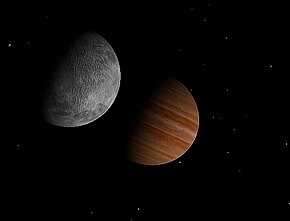HD 154345 b is a Jupiter-mass extrasolar planet orbiting the star HD 154345.
 Planet HD 154345 b (min mass ~1 MJ) in the background with two hypothetical moons visible. Image was created with Celestia V1.41 using a custom map for the Planet and its moons | |
| Discovery[1] | |
|---|---|
| Discovered by | Wright et al. |
| Discovery site | United States |
| Discovery date | March 12, 2006 (published: May 27, 2007) |
| radial velocity | |
| Orbital characteristics[2] | |
| 4.2+0.14 −0.15 AU | |
| Eccentricity | 0.157+0.03 −0.029 |
| 3342±40 d 9.15±0.11 yr | |
Average orbital speed | 13.7 |
| Inclination | 69°+13° −12° or 111°+12° −13° |
| 77°+38° −53° | |
| 2458428+72 −116 | |
| 319.6°+8.7° −8.4° | |
| Semi-amplitude | 14.28 ± 0.75 |
| Star | HD 154345 |
| Physical characteristics[2] | |
| Mass | 1.19+0.14 −0.11 MJ |
Discovery
editWright et al. discovered the planet in March 2006 using the radial velocity method to detect the small wobbling movement of the star caused by the gravity of the planet. The discovery was published in May 2007.[1]
While the existence of HD 154345 b has been unclear due to the correlation of its orbital period with the star's activity cycle,[3] a study in 2021 further confirmed its planetary nature.[4] In 2023, the inclination and true mass of HD 154345 b were determined via astrometry.[2]
Characteristics
editThe planet has a mass slightly greater than that of Jupiter. It orbits its parent star at a distance of 4.18 AU. Its orbital period is about 9.15 Earth years and its orbit is near-circular.[2] There are no interior planets of minimum mass (m sini) greater than 0.3 Jupiter.[5] Jupiter-like planets with these orbital and system characteristics are unlikely to be perturbed from the star's inclination.[6] Since the star's inclination is known as around 50°, this would make the planet's most likely mass greater than Jupiter's mass but less than twice that mass.[7]
As such HD 154345 b is presumed to be a gas giant "Jupiter twin".[5] Depending on composition the two planets may be around the same size, or HD 154345 b may be larger. This planet may also harbor a system of moons and rings.[citation needed]
See also
editReferences
edit- ^ a b Wright, J. T.; et al. (2007). "Four New Exoplanets and Hints of Additional Substellar Companions to Exoplanet Host Stars". The Astrophysical Journal. 657 (1): 533–545. arXiv:astro-ph/0611658. Bibcode:2007ApJ...657..533W. doi:10.1086/510553. S2CID 35682784.
- ^ a b c d Xiao, Guang-Yao; Liu, Yu-Juan; et al. (March 2023). "The Masses of a Sample of Radial-Velocity Exoplanets with Astrometric Measurements". Research in Astronomy and Astrophysics. 23 (5). arXiv:2303.12409. Bibcode:2023RAA....23e5022X. doi:10.1088/1674-4527/accb7e. S2CID 257663647.
- ^ Wright, J. T. (October 2015). Boisse, I.; Demangeon, O.; Bouchy, F.; Arnold, L. (eds.). Twenty Years of Precise Radial Velocities at Keck and Lick Observatories. Proceedings of colloquium 'Twenty years of giant exoplanets' held at Observatoire de Haute Provence, France, October 5-9, 2015. Observatoire de Haute-Provence, Institut Pythéas. pp. 8–17. arXiv:1603.08384. Bibcode:2015tyge.conf....8W.
- ^ Rosenthal, Lee J.; Fulton, Benjamin J.; Hirsch, Lea A.; Isaacson, Howard T.; Howard, Andrew W.; Dedrick, Cayla M.; Sherstyuk, Ilya A.; Blunt, Sarah C.; Petigura, Erik A.; Knutson, Heather A.; Behmard, Aida; Chontos, Ashley; Crepp, Justin R.; Crossfield, Ian J. M.; Dalba, Paul A.; Fischer, Debra A.; Henry, Gregory W.; Kane, Stephen R.; Kosiarek, Molly; Marcy, Geoffrey W.; Rubenzahl, Ryan A.; Weiss, Lauren M.; Wright, Jason T. (2021). "The California Legacy Survey. I. A Catalog of 178 Planets from Precision Radial Velocity Monitoring of 719 Nearby Stars over Three Decades". The Astrophysical Journal Supplement Series. 255 (1): 8. arXiv:2105.11583. Bibcode:2021ApJS..255....8R. doi:10.3847/1538-4365/abe23c. S2CID 235186973.
- ^ a b Wright, J. T.; et al. (2008). "The Jupiter Twin HD 154345b". The Astrophysical Journal Letters. 683 (1): L63 – L66. arXiv:0802.1731. Bibcode:2008ApJ...683L..63W. doi:10.1086/587461. S2CID 16808434.
- ^ Roberto Sanchis-Ojeda; Josh N. Winn; Daniel C. Fabrycky (2012). "Starspots and spin-orbit alignment for Kepler cool host stars". Astronomische Nachrichten. 334 (1–2): 180–183. arXiv:1211.2002. Bibcode:2013AN....334..180S. doi:10.1002/asna.201211765. S2CID 38743202.
- ^ Simpson, E. K.; et al. (November 2010), "Rotation periods of exoplanet host stars", Monthly Notices of the Royal Astronomical Society, 408 (3): 1666–1679, arXiv:1006.4121, Bibcode:2010MNRAS.408.1666S, doi:10.1111/j.1365-2966.2010.17230.x, S2CID 6708869